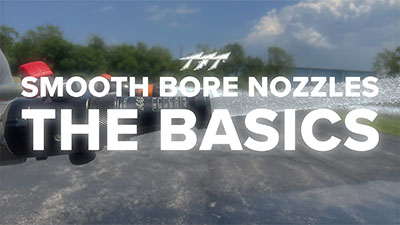What is a Smooth Bore Firefighting Nozzle?
The smooth bore nozzle (or smoothbore nozzle) has been a staple of firefighting for well over a century. It’s the original nozzle and is still in use today – for good reason!
Let’s dive into what a smooth bore nozzle is, how it works, and why it has stayed in use for so many decades.
What is a Smooth Bore Nozzle?

A smooth bore nozzle is a firefighting nozzle that has a smooth, tapered waterway. This tapered waterway directs water from the outlet of the hose to an exit orifice while building water pressure. This smooth waterway paired with increased pressure shapes the water into a solid stream. Smooth bores are known for providing excellent GPM and stream quality even with lower pump pressures.
Smooth bore nozzles are also known as solid bore nozzles or solid stream nozzles.
How Does a Smooth Bore Work?
A smooth bore builds pressure at a specific flow rate due to its smooth, tapered waterway. That tip pressure or exit pressure at a specific flow rate allows the stream to achieve adequate reach and penetration.
To illustrate what happens with the nozzle, think about the last time you placed your thumb over the opening of your garden hose. When you narrowed the escape path for the water, pressure built, and the water sprayed from the opening with more force and reach than before.
A smooth bore nozzle uses the same principle to build pressure and increase the reach penetration of the water stream at an adequate firefighting flow rate.

What are the Pros and Cons of Using Smooth Bore Nozzles?
Every nozzle has positives and negatives associated with it. Here are just a few pros and cons related to the smooth bore.
Pros
-
Solid stream nozzles are simple and have a no-frills design.
-
You can achieve good flow, reach, and penetration even with lower pump pressures.
-
Since the nozzle does not have any selection dials you cannot accidentally move into a fog pattern.
Cons
-
The Smooth bore does not have a fog or broken pattern option. This means you would need to gate the nozzle to achieve a broken pattern, which lowers your flow rate.
-
Smoothbores can be over or under pumped which will affect your reach and nozzle reaction.
-
The water is shaped by the waterway and exit orifice. If either is damaged or scratched, you may experience turbulence and lose your stream quality.
-
If you find yourself in need of more gpm, you cannot choose another option on your nozzle. You need to shut down the line and replace your tip first.
Why are Smooth Bores Still Used in the Fire Service?

Smooth bores have a reputation for being simple and effective. With no moving parts, they’re known to be reliable and easy to use and maintain. In addition, they can last for many years with proper use and care. In the fire service, it’s important to have equipment that can take a beating and keep on working.
This doesn’t mean other nozzle types tend to be faulty or less effective, though! Often, the choice of nozzle style is a personal preference that hearkens back to a firefighter’s training and individual experiences. While some firefighters lean toward using smooth bores, others prefer to use a selectable, fixed GPM, or automatic nozzle instead.
Should You Use a Smooth Bore Nozzle?
The decision to use a smooth bore nozzle is up to you and your crew! Each firefighter has their preferences in nozzles and the best way to find yours is to try them, train with them, and stay informed of the latest research and innovations. It’s also important to consider the needs of the fire ground you typically experience. You may end up preferring a smooth bore for one type of fire and favoring another style in a different scenario.
It is important to note that your water supply situation can affect your success when using a smooth bore. Poor, variable, or unpredictable water supplies can impact your reach and stream quality. However, if you have predictable, consistent water supplies, a smooth bore can be a great choice for you!
Before you go, here’s a quick video explaining how a smooth bore works and how flow rate and nozzle pressure are related.
